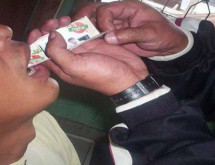Este informe solo está disponible en inglés.
Leer esta página en español mediante Google Translate.
Leer el informe en español mediante Google Translate.
Northeast India is a region with serious drug use problems. This briefing examines the drug-related problems and evaluates the policy responses in Nagaland and Manipur, two sparsely populated states in that region, bordering Burma. These states have the highest prevalence of injecting drug users (IDUs) in India. Unsafe practices, especially needle sharing among IDUs, have been the main drivers of the HIV/AIDS epidemic in the region. By the end of the 1990s, Manipur had become the “AIDS capital of India”, and also Nagaland is suffering a high incidence of HIV among injecting drug users.
More recently, there has been a shift from injecting heroin to injecting pharmaceuticals causing other severe health problems, including abscesses leading to life threatening infections, and eventual amputations. Although antiretroviral therapy (ART) is now accessible in Northeast India, many drug users also suffer from hepatitis C infection, now their main cause of mortality, as affordable treatment is not available.
Northeast India is an isolated and mountainous area, home to a wide range of different ethnic groups, each with its own distinct culture, traditions and language. Many of these ethnic groups are in conflict with the Indian government, demanding more autonomy or independence. Several ethnic movements are in armed struggle, pressing for their political demands. There has also been communal violence between villages of different ethnic groups.
Conflict and underdevelopment in the region have contributed to drug consumption and production, and are hampering access to treatment, care and support for drug users. Obstacles include curfews imposed by the national government, as well as punitive actions by armed opposition groups against drug users, and discrimination and stigmatization from the local population.
The seriousness of the situation brought unconventional responses. In 1996 Manipur was the first state in India to adopt an AIDS policy that included a harm reduction approach addressing vulnerable groups such as injecting drug users. Nevertheless, the new policies and services have proved inadequate to deal with the scale of the problems. However, there exists a strong community sense among ethnic groups in Northeast India, and society is well organized locally. Hence community-based organizations and self-help groups have taken it upon themselves to respond to problems posed by drug use and the related health crises.
Conclusions and Recommendations
- The Northeast of India has seen dramatic shifts in drugs use patterns, from smoking opium and heroin to injecting heroin and pharmaceuticals.
- Unsafe behaviour among injecting drug users is the driving factor behind HIV and hepatitis C epidemics. Injecting of pharmaceuticals is causing serious health problems.
- The funding of the National AIDS Control Organization (NACO) has to be improved to ensure that these are used effectively and reach the most at risk populations.
- Although ART is now accessible for people living with HIV/AIDS, many drug users suffer from hepatitis C infection, which is now the main cause of mortality.
- Services for drug users need to be improved and increased, guided by harm reduction principles. Hepatitis C prevention and access to hepatitis C treatment is urgent.
- Access to oral substitution therapy (OST) needs to be increased. Following the approval of methadone as an opioid substitute, programmes should be established.
- Local authorities, including the police and non-state actors, should stop discrimination and mistreatment of drug users, and should allow them free access to services.
- More adequate responses are needed to address the specific problems of female drug users. A drop-in centre with a night shelter, reintegration programmes and sensitisation should be high on the agenda.
Pages: 12

